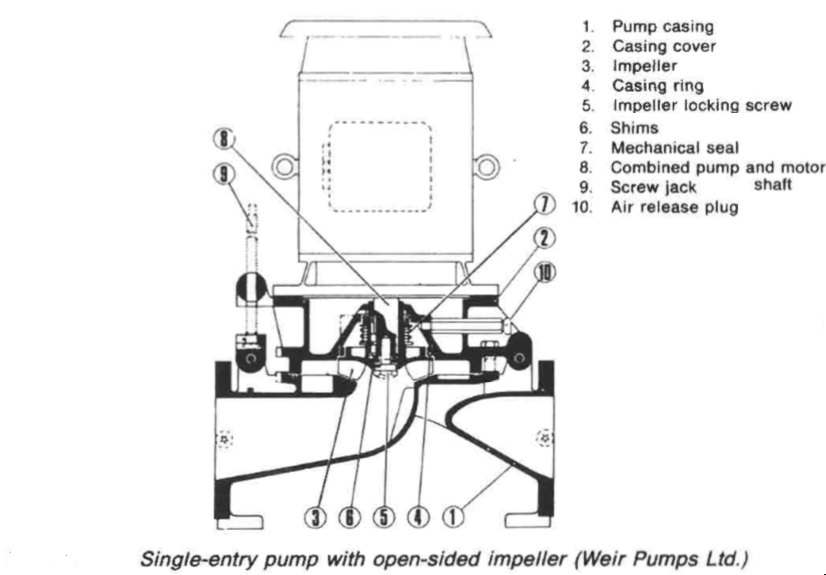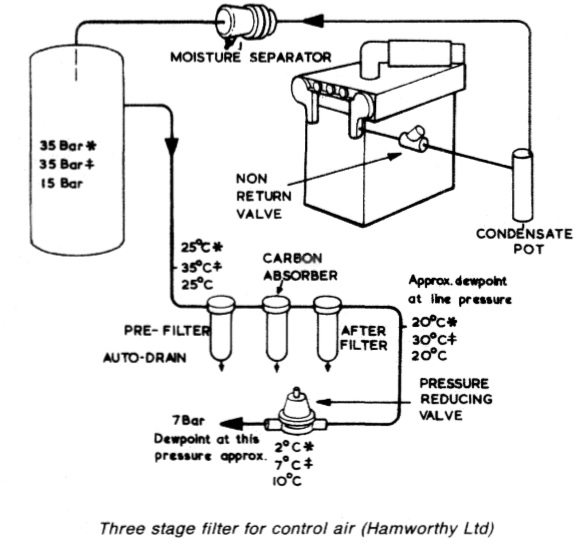
Home page||Marine Pumps ||
Centrifugal pump cavitation & Centrifugal pumps for lubricating oil duties
During operation, if the drop in pressure created at the suction side of a centrifugal pump (by liquid moving radially outwards from the eye of the impeller) is greater than the vapour pressure for the temperature of the liquid being pumped, then vapour will be drawn from the liquid in this area. The phenomenon is likely to occur if there is a restriction in the suction pipe, if the liquid is volatile or has a higher temperature than anticipated, or if the impeller speed is excessive.
A vapour cavity of this type is likely to cause loss of suction or erratic operation. A lesser cavitation problem occurs when NPSH required by the pump is only just matched by the NPSH available from the system, because centrifugal pumps have features which promote localized cavitation. The impeller entry on the side away from the shaft has a profile which resembles that of a hydrofoil, and local liquid flow creates a drop in pressure
which starts at the effective leading edge and extends along the surface.
A vapour pocket created by a drop in pressure at this surface would collapse in an area of higher pressure and cause cavitation damage. A change of flow direction from axial to radial causes the fluid to experience different velocities and at the extremity, a drop in pressure could produce cavitation, again with subsequent bubble collapse and damage. The types of cavitation described could cause surface roughening and generate some tell-tale noise. Corrosion wastage could cause impeller wastage but the cast iron casing of a sea-water pump is a prime target.
Centrifugal pumps for lubricating oil duties
Because of their self-priming ability, positive displacement pumps are widely used for lubricating oil duties. This practice is completely satisfactory in installations where the pump speed is variable but when the pump is driven by a constant speed a.c. motor it is necessary to arrange a bypass which can be closed in to boost flow. By using a centrifugal pump with an extended spindle, such that its impeller can be located at the bottom of the oil tank, the H/Q characteristics of the centrifugal pump can be utilized without the priming disadvantages. Known as the tank type pump this pump has a small open impeller.
It can be driven directly by a high speed alternating current motor without capacity restrictions, whereas the permissible operating speed of the
positive displacement type, pumping an incompressible fluid, decreases as the capacity increases. The pump will deliver an increased amount of oil as the system resistance is reduced, when the oil temperature rises and viscosity falls. In practice this is what the engine requires.

Figure : Comparison of centrifugal and positive displacement pump characteristics with respect to lubricating oil duties
A conventionally mounted self-priming pump is satisfactory for this duty if the suction pipe is short, direct and generously dimensioned. In a positive displacement pump the output varies little, if at all. The latter point is readily appreciated on reference to Figure above in which, for simplicity, the effect of a change in the viscosity of the oil on the pump characteristics has been omitted, although this would favour the centrifugal pump and enhance the comparison still further.

Figure 1: Single-entry pump with open-sided impeller (Weir Pumps Ltd.,
Summarized below some of the basic procedure of marine pumps and pumping system onboard :
- Axial flow pumps
An axial flow pump is one in which a screw propeller is used to create an increase in pressure by causing an axial acceleration of liquid within its blades. The incidental rotation imparted to the liquid is converted into straight axial movement by suitably shaped outlet guide vanes.....
- centrifugal pumps
Rotation of a centrifugal pump impeller causes the liquid it contains to move outwards from the centre to beyond the circumference of the impeller. The revolving liquid is impelled by centrifugal effect.....
- Centrifugal pump cavitation
Because of their self-priming ability, positive displacement pumps are widely used for lubricating oil duties. This practice is completely satisfactory in installations where the pump speed is variable but when the pump is driven by a constant speed a.c. motor it is necessary to arrange a bypass which can be closed in to boost flow. ....
- Gear pumps
Diesel engine and gearbox lubrication systems are normally supplied by gear
pumps which are independently driven for large slow speed engines and
stand-by duties but usually shaft driven for medium and high speed engines.
Gear pumps are also used for fuel and oil transfer, boiler combustion systems
and other duties.....
- General pumping system characteristics
A pump divides its pipe system into two distinct parts, each with different
characteristics. These are the suction and discharge sides. On the suction side
the drop in pressure that can be produced by a pump is limited to that of an
almost perfect vacuum. On the discharge side there is theoretically, no limit to
the height through which a liquid can be raised.....
- General purpose pumps
Single entry general purpose pumps are used for salt and fresh water circulating and also for bilge and ballast duties. The impeller is suspended from the shaft with no bottom support. ....
- Lobe pumps
Lobe pumps as manufactured by Stothert and Pitt have inner and outer
elements which rotate in a renewable liner fitted in the pump body. The inner
rotor is eccentric to the outer and is fitted to a shaft located by bearings in the
pump covers....
- Marine pumps construction
Marine pumps are usually installed with the shaft vertical and the motor above the pump. This positions the pump as low as possible for the best NPSH, takes up the least horizontal space and leaves the electric motor safer from gland or other leakage.....
- Pumps erosion
A pump handling liquids which contain abrasives, will suffer erosion on all internal surfaces, including bearings and shaft seals. The sea-water circulating pumps of ships operating in waters that contain large quantities of silt and sand
require frequent renewal of shaft seals or packing, also of shaft sleeves in way of the gland and bearings.....
- Rotary displacement pump
Positive displacement rotary pumps rely on fine clearances between moving
parts for their efficient operation. Excessive wear or erosion of parts, due to
friction contact or the presence of abrasives, is avoided by employing this type
of pump for specialized rather than general duties......
- Screw pumps
Both double-screw pumps, in which the screws are driven in phase by timing
gears , and triple screw pumps , in which the centre
screw is driven and the outer screws idle are used at sea especially for pumping
high viscosity liquids such as oil and some liquid cargoes.....
Figure 5.17 A two-stage centrifugal pump, typical of a fire pump (Hamworthy Engineering Ltd.)
Figure S.16 Performance curves for different width impellers of the same diameter and constant speed
Figure 5.18 Dredge pump (GEC-Elliot Mechanical Handling)

Figure : Three stage filter for control air (Hamworthy Ltd)
Home page||Cooling ||Machinery||Services ||Valves ||Pumps ||Auxiliary Power ||Propeller shaft ||Steering gears ||Ship stabilizers||Refrigeration||Air conditioning ||Deck machinery||Fire protection||Ship design
||Home ||
General Cargo Ship.com provide information on cargo ships various machinery systems -handling procedures, on board safety measures and some basic knowledge of cargo ships that might be useful for people working on board and those who working in the terminal. For any remarks please
Contact us
Copyright © 2010-2016 General Cargo Ship.com All rights reserved.
Terms and conditions of use
Read our privacy policy|| Home page||


